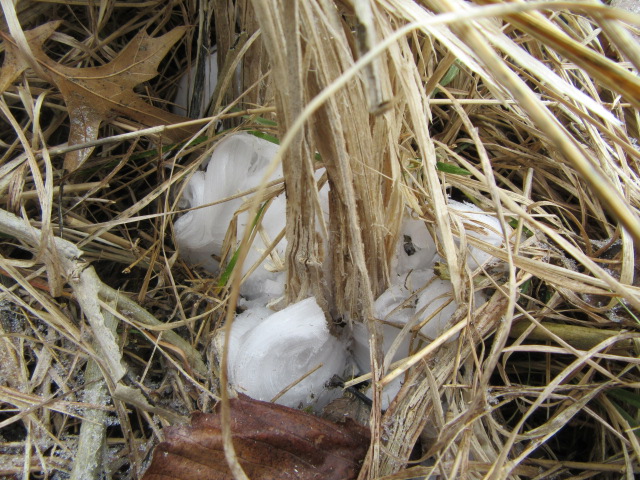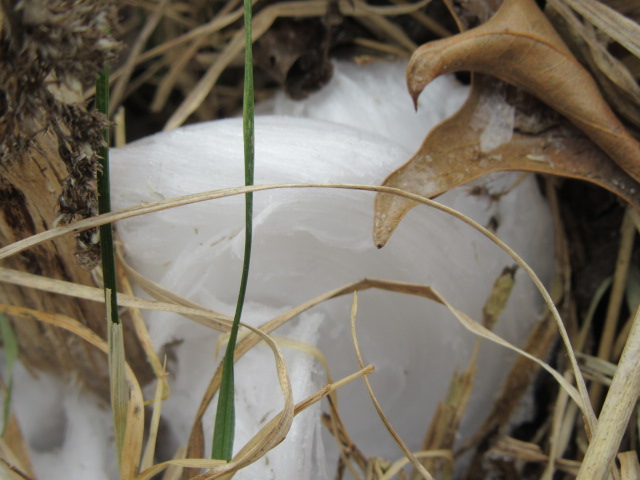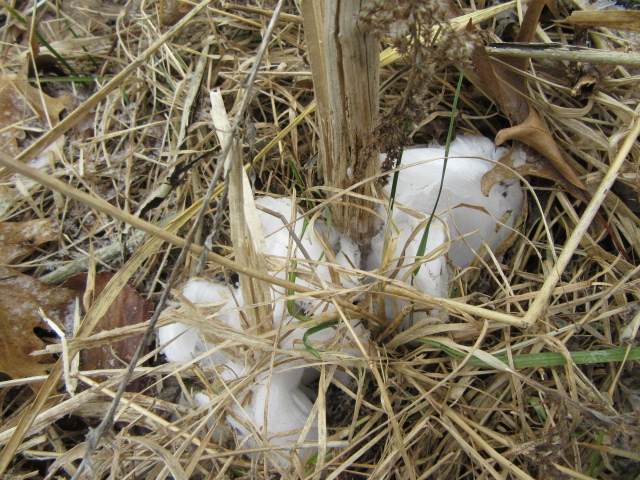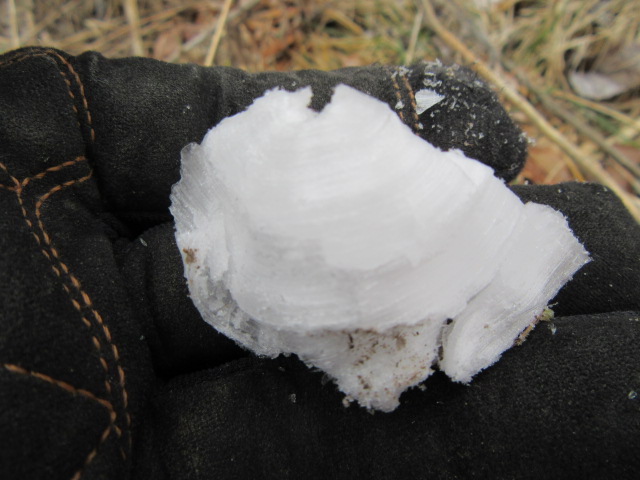
Verbesina virginica (White Crownbeard, Frostweed) on 9-2-22, #908-39.
White Crownbeard, Frostweed, Iceweed, Tickweed
Verbesina virginica
ver-bes-SIGH-nuh vir-JIN-ih-kuh
Synonyms of Verbesina virginica (11) (Updated on 12-4-23 from Plants of the World Online): Phaethusa laciniata Small, Phaethusa virginica Britton, Sigesbeckia laciniata Poir., Verbesina laciniata Walter, Verbesina laciniata Nutt., Verbesina polycephala DC., Verbesina sinuata Elliott, Verbesina villosa Nutt., Verbesina virginica var. insularis B.L.Rob. & Greenm., Verbesina virginica var. laciniata A.Gray, Verbesina virginica var. mollissima B.L.Rob. & Greenm.
Verbesina virginica L. is the accepted scientific name for the White Crownbeard. The genus and species were named and described as such by Carl von Linnaeus in the second edition of Species Plantarum in 1753.
As of 12-4-23 when this page was last updated, Plants of the World Online by Kew lists 350 species in the Verbesina genus. It is a member of the plant family Asteraceae with 1,702 genera. These figures could change as updates are made on POWO. The number of genera in the family fluctuates quite often.

Distribution map for Verbesina virginica from the USDA Plants Database. Published on the internet at https://plants.sc.egov.usda.gov/home. Retrieved on June 7, 2021.
The above distribution map for Verbesina virginica is from the USDA Plants Database. Areas in green are where the species is native. The map on Plants of the World Online doesn’t show as many states and also includes the species as being introduced to Jawa. Some data used to calculate where the species is native may be very old and not be currently present. On the other hand, the species could be more widespread.
The map on iNaturalist shows where members have made observations. Anyone can join and it is a great website to confirm and share your observations. Maps on iNaturalist are updated as members post new observations.
THERE ARE SEVERAL LINKS AT THE BOTTOM OF THE PAGE FOR FURTHER READING AND TO HELP WITH A BETTER POSITIVE ID.

Verbesina virginica (White Crownbeard) on 9-20-20, #744-36.
There are a lot of interesting wildflowers here on the farm, but the Verbesina virginica is high on the list. I started getting more into wildflower ID in 2018 and this species was a great find. I found a small colony along the boundary fence in the front pasture and since then it has become one of my favorite wildflowers. There are more photos are at the bottom of the page under the links for further information taken from 2018 through 2023. I take a lot of photos for this site plus I add them as observations on iNaturalist. It is very addictive.
I also found a nice colony of Verbesina alternifolia (Wingstem) on a friend’s farm in 2019.
You can get an idea of its range by looking at the map. The Missouri Plants website says it is found in the southern half of Missouri. You can zoom in on the map on the USDA Plants Database to get an idea if it is present in your county. The problem is, it isn’t exactly accurate or up-to-date. The map of Missouri shows it is not present in the county I live in or even close by. But, as you can see from the photos, the species is alive and well here.

Verbesina virginica (White Crownbeard/Frostweed) on 9-2-22, #908-38.
Verbesina virginica is a perennial wildflower that can grow to a height of at least 6-7’ tall. The stems are densely pubescent with very short curved hairs giving them a felty texture. Of course, they have fleshy longitudinal wings. Younger stems are green with creamy-green streaks, while the stems on older plants are green with maroon streaks.
The above photo shows where the flowering stems emerge from the axils of the leaf stem (petiole).
When freezing temps arrive, frost flowers are formed along the stems and later from the base. I took photos (farther down) on January 20 in 2023.

Verbesina virginica (White Crownbeard/Frostweed) on 7-17-21, #813-61.
The above photo was taken on July 17 in 2021. As you can see, the stems are a creamy green and the wings are green… You can also see how the right margin of the leaf on the left is an extension of the wing of the stem below the leaf. The left margin of the leaf on the right) is attached to the wing on the stem going upward. Hmmm…

Verbesina virginica (White Crownbeard, Frostweed) on 8-8-22, #903-34.
The leaves grow in an alternate pattern along the stems and are said to be narrowly elliptic or lanceolate-elliptic to ovate. In other words, they are broad and long, tapering to a point. The base of the leaves narrow to become winged petioles that extend down to the stem. The largest leaves can be around 7-10” long and 2-4” wide. The leaves on the floral stems and in the inflorescence are much smaller and lance-shaped. The upper surface of the leaves are sparsely to moderately pubescent with short, fine, broad-based hairs that give a sandpapery feel. The undersides of the leaves have a felty texture similar to the stems. The margins are kind of wavy and have widely spaced shallow teeth. The lower leaves fall off later in the growing season.

Verbesina virginica (White Crownbeard, Frostweed) on 9-2-22, #908-39.
The stems terminate in panicles of 40-200 flower heads with 2-4 flower heads per cluster 1-1 1/2” across. The heads are subtended by 8-13 involucral bracts.

Verbesina virginica (White Crownbeard, Frostweed) on 9-2-22, #908-40.
The above photo is a side-view that shows the fuzzy pedicels and peduncles. We can just call them flower stems and make it simple. You can also see the involucral bracts.

Verbesina virginica (White Crownbeard, Frostweed) on 9-2-22, #908-41.
The flowers consist of 1-5 tubular, pistillate ray florets and 8-12 disc florets per head. The white corollas are somewhat drooping and notched at the tip. The white styles of the ray florets become exerted, spit, and recurve. The disc florets have five stamens with elongated dark purple anthers that are fused into a ring.
The corollas attach to the top of the ovaries and have a pappus with two awns beside them, which is also attached to the tip of the ovaries. The pappus is a highly modified calyx.

Verbesina virginica (White Crownbeard, Frostweed) on 10-12-22, #918-13.
Disc flowers, if fertilized, produce one-seeded achenes with two awns at the notched tip.
<<<<2023>>>>

Verbesina virginica (White Crownbeard/Frostweed) on 1-30-23, #928-1.
There are A LOT of great photos online of frost flowers but I hadn’t ventured out to see them in person until January 30 in 2023. I am not a fan of cold temps, especially the first freeze. The largest colony of Verbesina virginica is all the way down to the boundary fence along the south side of the farm (in the front pasture). Well, to be honest, it isn’t all that far, maybe 5-10 minutes. It was 16° F when I decided to go which made the trip must faster.

Verbesina virginica (White Crownbeard/Frostweed) on 1-30-23, #928-2.
When I got to the spot, of course, all the stems were dead. I looked around a bit, and finally noticed globs of ice at the bottom of two stems about 2′ apart. I got down on my hands and knees to have a closer look and sure enough, they were frost flowers.

Verbesina virginica (White Crownbeard/Frostweed) on 1-30-23, #928-3.
Water oozes out of the stems during the first freeze and makes some of the neatest ice sculptures. I thought this was a one-time thing, but during subsequent freezes, ice is formed at the base of the plant. This happens as long as the ground isn’t frozen (or at least not too deep).

Verbesina virginica (White Crownbeard/Frostweed) on 1-30-23, #928-4.
The ice is very thin and delicate. Kind of like a frozen ribbon of ice.

Verbesina virginica (White Crownbeard/Frostweed) on 1-30-23, #928-5.
Verbesina virginica isn’t the only species that forms frost flowers. A blogger friend from Texas mentioned Pluchea odorata (Marsh Fleabane) which isn’t found in Missouri. The Wikipedia article mentions Verbesina alternifolia (Wingstem), Cunila origanoides (Dittany) from the plant family Lamiaceae, and Helianthemum canadense (Longbranch Frostweed) (Syn. of Crocanthemum canadense (Canada Frostweed) from the plant family Cistaceae. Pluchea odorata is in the plant family Asteraceae with Verbesina alternifolia and V. virginica.
I will continue taking more photos of the Verbesina virginica.
The Arkansas Native Plant Society has a GREAT write-up about Verbesina virginica. All their “Know Your Natives” articles are excellent!
I have enjoyed photographing and learning about the many wildflowers growing on the farm and in other areas. The farm is located in Windsor, Missouri in Pettis County (Henry County is across the street, and Benton and Johnson aren’t far away). I have grown over 500 different plants and identified over 250 species of wildflowers (most have pages listed on the right side of the page). I am not an expert, botanist, or horticulturalist. I just like growing, photographing, and writing about my experience. I rely on several websites for ID and a few horticulturalists I contact if I cannot figure them out. Wildflowers can be somewhat variable from location to location, so sometimes it gets a bit confusing. If you see I have made an error, please let me know so I can correct what I have written.
I hope you found this page useful and be sure to check the links below for more information. They were written by experts and provide much more information. Some sites may not be up-to-date but they are always a work in progress. If you can, I would appreciate it if you would click on the “Like” below and leave a comment. It helps us bloggers stay motivated. You can also send an email to me at thebelmontrooster@yahoo.com. I would enjoy hearing from you especially if you notice something is a bit whacky.
FOR FURTHER READING:
PLANTS OF THE WORLD ONLINE (GENUS/SPECIES)
INTERNATIONAL PLANT NAMES INDEX (GENUS/SPECIES)
TROPICOS (GENUS/SPECIES)
FLORA OF NORTH AMERICA (GENUS/SPECIES)
WORLD FLORA ONLINE (GENUS/SPECIES)
WIKIPEDIA (GENUS/SPECIES)
USDA PLANTS DATABASE
DAVE’S GARDEN
DAVE’S GARDEN-ARTICLE
MISSOURI PLANTS
MISSOURI DEPARTMENT OF CONSERVATION
iNATURALIST
WILDFLOWER SEARCH
ARKANSAS NATIVE PLANT SOCIETY
KANSAS WILDFLOWERS AND GRASSES
NEWS FROM ROCKCLIFF FARM
LADY BIRD JOHNSON WILDFLOWER CENTER
GARDENIA
BACKYARD NATURE
NATIVE PLANTS OF THE CAROLINAS AND GEORGIA
NATIVE PLANT SOCIETY OF TEXAS
U.S. WILDFLOWERS
CLAY AND LIMESTONE
NOTE: The data (figures, maps, accepted names, etc.) may not match on these websites. It depends on when and how they make updates and when their sources make updates. Some websites have hundreds and even many thousands of species to keep up with. Accepted scientific names change periodically and it can be hard to keep with as well. Some of the links may use a name that is a synonym on other sites. In my opinion, Plants of the World Online by Kew is one of the most reliable and up-to-date plant databases and they make updates regularly. I make updates “at least” once a year and when I write new pages or add new photos but I do get behind. We are all a work in progress. 🙂
MORE PHOTOS…

Verbesina virginica (White Crownbeard) on 10-4-18, #515-35

Verbesina virginica (White Crownbeard) on 10-4-18, #515-36.

Verbesina virginica (White Crownbeard) on 10-4-18, #515-37.

Verbesina virginica (White Crownbeard) on 10-4-18, #515-38.

Verbesina virginica (White Crownbeard) on 10-4-18, #515-39.
<<<<2020>>>>

Verbesina virginica (White Crownbeard) on 9-20-20, #744-37.

Verbesina virginica (White Crownbeard) on 9-20-20, #744-38.

Verbesina virginica (White Crownbeard) on 9-20-20, #744-39.

Verbesina virginica (White Crownbeard) on 9-20-20, #744-40.

Verbesina virginica (White Crownbeard) on 9-20-20, #744-41.

Verbesina virginica (White Crownbeard) on 9-20-20, #744-42.

Verbesina virginica (White Crownbeard) on 9-20-20, #744-43.

Verbesina virginica (White Crownbeard) on 9-20-20, #744-44.

Verbesina virginica (White Crownbeard) on 9-20-20, #744-45.
<<<<2021>>>>

Verbesina virginica (White Crownbeard) on 7-17-21, #813-56.
I found a few Verbesina virginica growing along the fence in the south hayfield in 2021. I became fairly busy over the summer then forgot to take photos of them flowering…

Verbesina virginica (White Crownbeard) on 7-17-21, #813-57.

Verbesina virginica (White Crownbeard) on 7-17-21, #813-58.

Verbesina virginica (White Crownbeard) on 7-17-21, #813-59.

Verbesina virginica (White Crownbeard) on 7-17-21, #813-60.
<<<<2022>>>>

Verbesina virginica (White Crownbeard, Frostweed) on 5-28-22, #885-51.

Verbesina virginica (White Crownbeard, Frostweed) on 5-28-22, #885-52.

Verbesina virginica (White Crownbeard, Frostweed) on 8-8-22, #903-32.

Verbesina virginica (White Crownbeard, Frostweed) on 8-8-22, #903-33.

Verbesina virginica (White Crownbeard, Frostweed) on 8-8-22, #903-35.

Verbesina virginica (White Crownbeard, Frostweed) on 9-2-22, #908-36.

Verbesina virginica (White Crownbeard, Frostweed) on 9-2-22, #908-37.
<<<<2023>>>>

Verbesina virginica (White Crownbeard, Frostweed) on 6-4-23, #943-81.
In a new location in front of the walnut trees in the front pasture…

Verbesina virginica (White Crownbeard, Frostweed) on 6-4-23, #943-82.

Verbesina virginica (White Crownbeard, Frostweed) on 6-4-23, #943-83.

Verbesina virginica (White Crownbeard, Frostweed) on 9-10-23, #960-76.

Verbesina virginica (White Crownbeard, Frostweed) on 9-24-23, #963-51.

Verbesina virginica (White Crownbeard, Frostweed) on 9-24-23, #963-52.
I have this growing in my NW Arkansas backyard by a creek. It is in part sun. I always look forward to the frost flowers in the early winter. White crownbeard grows abundantly in our area along roads and in ditches. Thank you for helping me identify this plant!
LikeLiked by 1 person
Hello Gloria! I am very glad to hear you now have it figured out. They are one of my favorites for sure, but I have yet to see the frosty display. Maybe this year and what a treat that would be. Take care and thanks for the comment!
LikeLike